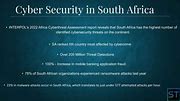Africa’s fintech landscape is abuzz with innovation, promising a brighter future for financial inclusion across the continent. As Oluwabankole Falade aptly puts it,
“The sector has grown an impressive 180% since 2020 and is projected to reach $65 billion in revenue by 2030.”
This growth trajectory underscores the pivotal role that fintech plays in transforming traditional banking services and reaching underserved populations.
Picture this: Africa, a continent where over half of adults lack access to conventional banking services but boasts mobile phone penetration exceeding 80% in Sub-Saharan Africa. This unique dynamic has paved the way for fintech companies to leverage mobile technology creatively. From bustling Lagos to vibrant Dar es Salaam, these companies are bridging the gap by providing essential financial services like mobile money transfers and digital lending to previously unbanked individuals.
However, despite this remarkable progress, one significant hurdle stands in the way—regulatory harmonisation. The fragmented regulatory frameworks across African countries pose challenges for businesses seeking to expand seamlessly across borders. As Falade notes,
“For multinational companies looking to grow their footprint in Africa, navigating through diverse regulatory environments means grappling with high compliance costs and limited accessibility to financial services.”
The economic diversity of Africa further complicates matters. With 54 countries each operating under distinct financial systems, achieving regulatory alignment becomes even more crucial. Among these nations, Nigeria, Kenya, South Africa, and Egypt emerge as the leading fintech markets attracting substantial investment. Nevertheless, countries like Ghana and Rwanda are also making strides in digital transformation.
To address these challenges effectively, experts propose adopting models of regulatory integration from other regions. For example, the EU’s Passporting Rule allows financial service providers authorized in one member state to operate seamlessly across all EU countries—a concept that could be transformative if implemented in Africa.
Imagine a scenario where fintechs licensed in Nigeria can effortlessly expand into Kenya or South Africa without encountering additional regulatory roadblocks. Such a system would not only streamline cross-border payments but also reduce costs significantly by enabling payment providers to offer their services across multiple markets without hindrance.
Recent initiatives such as the Memorandum of Understanding (MoU) between Ghana and Rwanda on regulatory passporting serve as promising examples of regional cooperation towards harmonisation. By allowing licensed fintechs from either country to broaden their services without additional approvals or compliance costs, this agreement sets a precedent for fostering financial inclusion through collaborative efforts.
Furthermore,Africa is already taking steps towards harmonisation through initiatives like the African Continental Free Trade Area (AfCFTA) and the Pan-African Payment and Settlement System (PAPSS). These efforts showcase that continental coordination is achievable; however success hinges on establishing a supportive regulatory environment that encourages innovation while safeguarding consumer interests.
As we look ahead into 2025 and beyond,Africa stands at a critical juncture with an immense opportunity to create a conducive regulatory framework that propels fintech innovation while ensuring consumer protection—
“Now is the time for fintech innovators,policymakers,and regulators to collaborate,”
urges Falade.
“By seizing this moment,Africa can unlock its full potential within the fintech space,directing millions towards greater financial inclusivity.”
In conclusion,the journey towards unlocking Africa’s Fintech Future entails overcoming regulatory hurdles,bolstering collaboration among key stakeholders,and prioritizing consumer-centric policies that pave the way for a more inclusive financial ecosystem.Africa’s Fintech revolution holds immense promise,but realizing its full potential requires concerted efforts,timely interventions,and most importantly,a shared vision focused on driving sustainable change.









Leave feedback about this